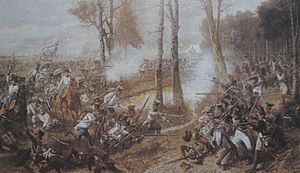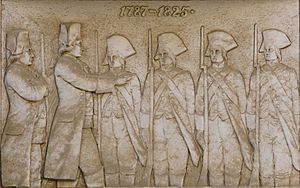Austrian Army during the French Revolutionary and Napoleonic Wars facts for kids

The Imperial Austrian Army was the main fighting force of the Habsburg monarchy. This powerful army served under its last ruler, Emperor Francis II. It was sometimes called the Imperial-Royal Army.
In 1806, the Holy Roman Empire ended. The army then became known as the army of the Austrian Empire. Emperor Francis II became Emperor Francis I of Austria.
Contents
Understanding the Imperial Austrian Army
The name "Imperial-Royal Army" was first used in 1745. "Imperial" referred to the Holy Roman Empire until 1804. After 1804, it meant the Austrian Empire. "Royal" referred to the Kingdom of Bohemia. This is different from "Imperial and Royal" used after 1867, which included the Kingdom of Hungary.
A Diverse Army: Many Nations, One Force
The Austrian army was unique because it included soldiers from many different lands. This was especially true during the Revolutionary and Napoleonic Wars (1792–1815). The army had two main types of units:
- "German" units: These included soldiers from Bohemia, Moravia, Silesia (Czechs), Galicia (Poles and Ruthenians), the former Austrian Netherlands (Flemings and Walloons), and Italy.
- "Hungarian" units: These included troops from Croatia, Serbia (from the Military Frontier), and Transylvania.
This mix of cultures meant training could be tricky. The army often faced money problems from the government. Despite this, it went through several changes to improve. For example, in 1795, a special commission worked for six years. They updated the soldiers' gear, creating a simpler uniform, a famous crested helmet, and a standard musket.
Key Battles and Leaders
The Austrian army fought many important battles. They won major victories against the French at:
- Neerwinden
- Würzburg
- Stockach
- Caldiero
- Aspern-Essling
- Leipzig
However, they also faced big defeats at places like:
- Jemappes
- Fleurus
- Rivoli
- Marengo
- Hohenlinden
- Ulm
- Austerlitz
- Wagram
One of the most important leaders was Archduke Charles, Duke of Teschen. He made many modern changes to the army, especially after the big loss at Austerlitz. Archduke Charles was famous for stopping Napoleon at the Battle of Aspern-Essling. He later retired from active command after the defeat at Wagram. The Austrian army also helped defeat Joachim Murat in the Neapolitan War of 1815.
How the Army Was Organized
The Austrian army had a special group of officers called "The Staff." This group helped the main commander make plans and manage the army.
The Role of the Staff Officers
In 1758, Count Leopold Joseph von Daun pushed for a more important role for the Generalquartiermeister (Chief of Staff). This was after problems in battles like Battle of Leuthen. It became clear that the army needed more "brains" to help the Commander-in-Chief. This would give the commander more time to think about big strategies.
A permanent staff of 30 officers was created. They were led by Franz Moritz von Lacy. This group would grow bigger during wartime. The staff was divided into three parts:
- Intrinsecum: Handled internal management and directing operations.
- External Activities: Included engineers and other outside tasks.
- Inspection Service: Managed orders and prisoners of war.
The Chief of Staff became the main advisor to the Commander-in-Chief. They started focusing on planning battles and operations. Other officers handled the daily tasks. Staff officers were chosen from regular army units and would return to them later. This helped them become better leaders.
When Karl Mack von Leiberich became Chief of Staff, he wrote down 19 rules for staff officers. These rules explained how they should help the Commander-in-Chief in both attack and defense. Archduke Charles, Duke of Teschen added his own ideas in 1796. He said the Chief of Staff must think about "all possibilities" and not just follow orders.
In 1801, Peter Duka von Kadar became the first peacetime Generalquartiermeister. This meant the Chief of Staff's job was now officially about planning and operations. Archduke Charles made new rules in 1805. He divided the staff into three more parts:
- Political Correspondence
- Operations Directorate (for planning and intelligence)
- Service Directorate (for management, supplies, and military law)
Archduke Charles clearly defined the modern Chief of Staff's role. He said, "The Chief of Staff stands at the side of the Commander-in-Chief and is completely at his disposal." He also said, "The Commander-in-Chief decides what should happen and how; his chief assistant works out these decisions." By 1809, each army corps had its own staff. In 1811, Joseph Radetzky von Radetz further improved the staff system. He made the Chief of Staff's role more about managing and overseeing different departments. This was the start of a formal group of staff officers who could specialize in different areas.
Recruiting Soldiers
In the German-speaking parts of the empire, soldiers joined either voluntarily or through conscription. Before 1802, conscription meant serving for life. After 1802, it was for ten years. All healthy men between 17 and 40 could be called to serve. However, many people were excused, like nobles, skilled workers, most townspeople, and married men. This meant most soldiers came from young sons of farmers and city workers. For Hungarian regiments, the Diet of Hungary (a type of parliament) decided how many soldiers each county had to provide.
Each regiment had its own area where it recruited soldiers. The only exception was the Poles from Galicia.
Officers: Leading the Troops
Every regiment had an honorary leader called the 'Inhaber'. This person's name was often part of the regiment's title. But they only had a formal role, mainly confirming the appointment of junior officers. Unlike what some French propaganda said, most Austrian officers were not just from rich families. Many started as cadets or were promoted from within the regiments.
The Infantry: Foot Soldiers
In 1793, the army had 57 line regiments. Each had two grenadier companies. There were also 17 Grenzer light infantry regiments. Three garrison regiments and the Stabs Infanterie Regiment handled headquarters duties. During wartime, extra light infantry battalions called Frei-Corps were also formed.
Line Regiments: The Main Force
From 1768 to 1805, a typical line regiment had two main battalions. These were the Leib- and Oberst- battalions. Each had six fusilier companies. There was also a grenadier division with two companies. These grenadier companies usually joined with others to form larger grenadier battalions.
Each regiment also had a garrison battalion. This battalion had four companies and provided reserve soldiers. A "German" line regiment was supposed to have 4,575 men. But in reality, it was often only 2,000 to 3,000, especially in peacetime. "Hungarian" regiments had three battalions and a planned strength of 5,508 men.
Company Strength: How Many Soldiers?
A line company had four officers:
- Hauptmann (Captain)
- Oberleutnant (1st Lieutenant)
- Unterleutnant (2nd Lieutenant)
- Fähnrich (Ensign)
There were 14 non-commissioned officers (NCOs) in a line company:
- Feldwebel (Sergeant)
- Four Corporals
- Fourierschützen (Quartermaster)
- Eight Gefreiter (Lance Corporals)
In peacetime, a company had 113 soldiers. During wartime, this number grew. Grenadier companies had 115 soldiers. Fusilier companies had 152-154 soldiers. Each company also had three musicians and a Zimmermann (pioneer). In wartime, the total number of soldiers in a company could range from 120 to 230. Grenadier companies had between 112 and 140 soldiers.
In 1805, a new organization was tried. Regiments had six battalions, each with four companies. But the army went back to its older organization in 1806.
Light Infantry: Fast and Flexible
The Grenzers formed the main part of the light infantry. In 1808, a regiment (IR64) was broken up. Its nine divisions formed new rifle-armed units. These were then combined with carbine-armed troops to create nine new Jäger battalions.
Army Rules and Training
The Austrian army had detailed rulebooks for training and service.
Early Regulations (1757–1805)
The main rulebook was the 1769 reglement fur die sammtliche kaiserlich-konigliche Infanterie. It had two volumes:
- Volume 1: Covered the jobs of each rank, military justice, camps, and reporting forms.
- Volume 2: Covered service rules for each rank, camp rules, basic drills, and how to form basic battle shapes.
The 1769 Generals-Reglement was the manual for generals and staff. There was also a 1757 Artillery regulation.
Reform Period Regulations (1806–1815)
Archduke Charles, Duke of Teschen believed in educating soldiers and officers. So, during the Second Reform period (1806–1808), new manuals were created:
- A) Dienst-reglement für die K.k.Infanterie: This was the basic service manual. It described job duties and service rules.
- B) Abrichtungs-Reglement (1806): This covered basic drill up to the company level.
These two manuals were essential. Every soldier had to know them.
- C) Exercier Reglement für die K.K. Infanterie (1807): This was for higher-level drills, up to regiment size. NCOs and officers had to know this one.
- D) Beiträge zum practischen Unterricht im Felde für die Officiere der österreichischen Armee (1806–1813): This was a series of small books for junior officers. They were short and had diagrams. They covered topics like:
* Outposts and patrols (1806) * Reconnaissance and marches (1807) * Skirmishing (1808) * Attacking and defending woods and villages (1808) * Attacking and defending large positions (1808) * Attacking and defending mountain passes and crossing rivers (1810) * Feints, sieges, and protecting supply trains (1811) * Obtaining supplies and winter positions (1813)
- E) Grundsätze der höheren Kriegs-Kunst für die Generäle der österreichischen Armee (1806): This was a small book about strategy for senior generals. It was updated in 1808.
Tactics: How They Fought
New rules in 1805 and 1807 did not change the main way battalions fought. They still used a three-rank line formation. For moving around, they used a "battalion-column." Austria was good at using light infantry for skirmishing. They also used the third ranks of line battalions for skirmishing. From 1808, they created formal and separate Jäger battalions.
The 1807 Exercier-Reglemnt made it official to train infantry skirmishers within their own battalions. It also introduced the use of "Masses" (battalions or two-company divisions grouped closely together). These formations were strong against cavalry and easier to move on the battlefield. While still weak against artillery, they were very effective in many situations.
The Artillery: Big Guns
The artillery used cannons to support the army. Some of these old guns still exist today. For example, there are 3-pounder gun parts in Forchtenstein Castle. A 3-pounder gun from 1814 is in the Zeughaus in Graz, Austria. There are also 6-pounder gun parts and a limber (a type of cart) in Schlossberg Castle in Graz. Cannon barrels can be seen outside the Museum of Military History, Vienna. A rebuilt 6-pounder gun is in the Military Museum in Budapest.
|
See Also
- Imperial Army (Holy Roman Empire)
- Army of the Holy Roman Empire
- Imperial Austrian Army (1806-1867)
- Flags of the Imperial Austrian Army of the Napoleonic Wars


